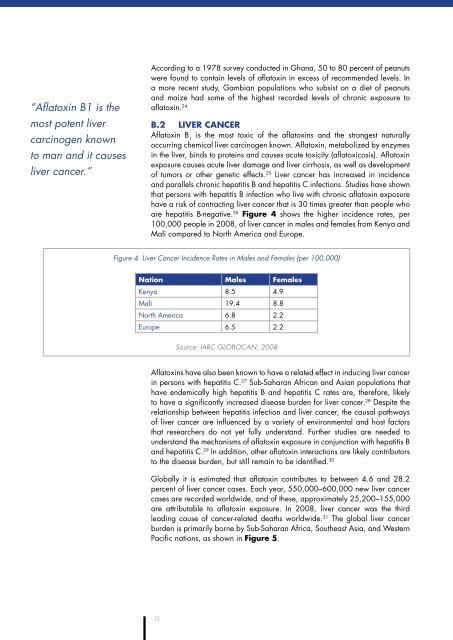Aflatoxin: A Synthesis of the Research in Health, Agriculture and Trade
Aflatoxin: A Synthesis of the Research in Health, Agriculture and Trade
Aflatoxin: A Synthesis of the Research in Health, Agriculture and Trade
Create successful ePaper yourself
Turn your PDF publications into a flip-book with our unique Google optimized e-Paper software.
“<strong>Aflatox<strong>in</strong></strong> B1 is <strong>the</strong><br />
most potent liver<br />
carc<strong>in</strong>ogen known<br />
to man <strong>and</strong> it causes<br />
liver cancer.”<br />
Accord<strong>in</strong>g to a 1978 survey conducted <strong>in</strong> Ghana, 50 to 80 percent <strong>of</strong> peanuts<br />
were found to conta<strong>in</strong> levels <strong>of</strong> aflatox<strong>in</strong> <strong>in</strong> excess <strong>of</strong> recommended levels. <strong>in</strong><br />
a more recent study, Gambian populations who subsist on a diet <strong>of</strong> peanuts<br />
<strong>and</strong> maize had some <strong>of</strong> <strong>the</strong> highest recorded levels <strong>of</strong> chronic exposure to<br />
aflatox<strong>in</strong>. 24<br />
B.2 liver cAncer<br />
<strong>Aflatox<strong>in</strong></strong> B 1 is <strong>the</strong> most toxic <strong>of</strong> <strong>the</strong> aflatox<strong>in</strong>s <strong>and</strong> <strong>the</strong> strongest naturally<br />
occurr<strong>in</strong>g chemical liver carc<strong>in</strong>ogen known. <strong>Aflatox<strong>in</strong></strong>, metabolized by enzymes<br />
<strong>in</strong> <strong>the</strong> liver, b<strong>in</strong>ds to prote<strong>in</strong>s <strong>and</strong> causes acute toxicity (aflatoxicosis). <strong>Aflatox<strong>in</strong></strong><br />
exposure causes acute liver damage <strong>and</strong> liver cirrhosis, as well as development<br />
<strong>of</strong> tumors or o<strong>the</strong>r genetic effects. 25 liver cancer has <strong>in</strong>creased <strong>in</strong> <strong>in</strong>cidence<br />
<strong>and</strong> parallels chronic hepatitis B <strong>and</strong> hepatitis c <strong>in</strong>fections. Studies have shown<br />
that persons with hepatitis B <strong>in</strong>fection who live with chronic aflatox<strong>in</strong> exposure<br />
have a risk <strong>of</strong> contract<strong>in</strong>g liver cancer that is 30 times greater than people who<br />
are hepatitis B-negative. 26 figure 4 shows <strong>the</strong> higher <strong>in</strong>cidence rates, per<br />
100,000 people <strong>in</strong> 2008, <strong>of</strong> liver cancer <strong>in</strong> males <strong>and</strong> females from Kenya <strong>and</strong><br />
Mali compared to north America <strong>and</strong> europe.<br />
Figure 4. Liver Cancer Incidence Rates <strong>in</strong> Males <strong>and</strong> Females (per 100,000)<br />
nation Males females<br />
Kenya 8.5 4.9<br />
Mali 19.4 8.8<br />
north America 6.8 2.2<br />
europe 6.5 2.2<br />
<strong>Aflatox<strong>in</strong></strong>s have also been known to have a related effect <strong>in</strong> <strong>in</strong>duc<strong>in</strong>g liver cancer<br />
<strong>in</strong> persons with hepatitis c. 27 Sub-Saharan African <strong>and</strong> Asian populations that<br />
have endemically high hepatitis B <strong>and</strong> hepatitis c rates are, <strong>the</strong>refore, likely<br />
to have a significantly <strong>in</strong>creased disease burden for liver cancer. 28 Despite <strong>the</strong><br />
relationship between hepatitis <strong>in</strong>fection <strong>and</strong> liver cancer, <strong>the</strong> causal pathways<br />
<strong>of</strong> liver cancer are <strong>in</strong>fluenced by a variety <strong>of</strong> environmental <strong>and</strong> host factors<br />
that researchers do not yet fully underst<strong>and</strong>. fur<strong>the</strong>r studies are needed to<br />
underst<strong>and</strong> <strong>the</strong> mechanisms <strong>of</strong> aflatox<strong>in</strong> exposure <strong>in</strong> conjunction with hepatitis B<br />
<strong>and</strong> hepatitis c. 29 <strong>in</strong> addition, o<strong>the</strong>r aflatox<strong>in</strong> <strong>in</strong>teractions are likely contributors<br />
to <strong>the</strong> disease burden, but still rema<strong>in</strong> to be identified. 30<br />
Globally it is estimated that aflatox<strong>in</strong> contributes to between 4.6 <strong>and</strong> 28.2<br />
percent <strong>of</strong> liver cancer cases. each year, 550,000–600,000 new liver cancer<br />
cases are recorded worldwide, <strong>and</strong> <strong>of</strong> <strong>the</strong>se, approximately 25,200–155,000<br />
are attributable to aflatox<strong>in</strong> exposure. <strong>in</strong> 2008, liver cancer was <strong>the</strong> third<br />
lead<strong>in</strong>g cause <strong>of</strong> cancer-related deaths worldwide. 31 <strong>the</strong> global liver cancer<br />
burden is primarily borne by Sub-Saharan Africa, Sou<strong>the</strong>ast Asia, <strong>and</strong> Western<br />
Pacific nations, as shown <strong>in</strong> figure 5.<br />
13<br />
Source: IARC GLOBOCAN, 2008


